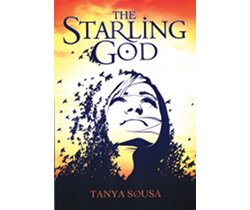
 copyright the Chronicle April 16, 2014
copyright the Chronicle April 16, 2014
The Starling God, by Tanya Sousa. Paperback. 265 pages. Published by forestrypress.com. $12.50
Reviewed by Tena Starr
Tanya Sousa’s The Starling God is part allegory, part adventure story, part coming of age tale, and very much a social commentary. She tackles the interconnectedness of species, the dangers of both conformity and superiority, and the pitfalls of blind and unquestioning adulation — for starters.
This is also a book written by a person who knows a great deal about birds and who is deeply passionate about her message.
The birds in this story have formed something of a religion with humans as the objects of worship. Humans are gods, or maybe they’re the blight, as the swallows — who are shunned for their heresy — believe.
The birds’ society is a complex one. There are watchers, who guard the other birds; cleaners, who take care of the dead; praisers, who sing out the news and the praise of the day each morning; seekers, who gather information; and tellers, who decide what information is wise to share.
And then there are the starlings, a flock apart.
SL’an, the main character in this book, is a starling, but he first appears in the bird world among doves, who come to his rescue when his “mother,” a woman who rehabilitates birds, returns him to the wild.
Poor SL’an spends a miserable night waiting for the only mother he’s ever known to retrieve him. When it becomes apparent that’s not going to happen, he accepts the kindness of the doves and begins to learn how to live in the bird world.
But bird lore says that one day an “Equal” will appear, one who is a bird but also an equal to humans. SL’an, with no memory of life aside from that with the woman, appears to be that one — the Starling God.
He adapts well under the gentle and affectionate tutelage of the doves and decides he would like to be both a seeker and a teller. Those plans are thwarted, however, when the starlings learn of his existence.
Bard, leader of the starlings, is of the belief that the starlings alone are closest to the gods and must stick together in their pursuit of becoming more like them. He forbids his young charges, the fledglings in training, to associate with other birds for fear their thinking will be tainted.
But SL’an is not lacking in courage, and his heart is in the right place. When tragedy strikes the doves, he returns to offer solace and assistance, much against the starling leader’s wishes.
Puzzled by the events that struck the doves, and an unsettling encounter with a fisher cat, SL’an decides to start immediately on his job as a seeker.
Who are these gods, really? What is the truth?
SL’an sets out on a quest to answer those questions. He meets confined chickens too breast heavy to walk, too dulled in the brain to speak. He meets grackles killed by farmers, who resent the theft of food. Other birds offer the grackles no warning about the poisoned food, believing that the grackles have displeased the gods and it is not for them to interfere. He meets cows who know nothing of grass under their feet.
In other words, he encounters corporate farming.
He meets cities where birds happily feed off the scraps of humans. The concrete, and the food, dispirit him.
The quest leads him, ultimately, to his own truth. Humans are neither gods nor blight. They are good, they are cruel, and they are fallible.
In the words of a wise whale: “They are the ones that have completely forgotten what they are and how they belong — so completely that they can’t receive what they need to hear from all of their family. We are all family, forged from the same and of the same, but they stopped knowing this. Without this, they have no guide for how to live.”
A good story has a memorable character, and SL’an is that. He’s a plucky little fellow, charming, honest, and loyal. And the book moves along like an adventure story, with moments of tragedy, joy, grief, and tension. It’s reminiscent of both Jonathan Livingston Seagull and Watership Down.
Ms. Sousa seems a little worried that some may dislike the fact that she’s anthropomorphized the birds. However, she notes that science steadily turns up evidence that animals do experience emotions and have language.
As a story, it works. The characters are rich and well drawn. Although they are given human thought and reactions, they also retain the qualities of their species.
Tanya Sousa has written a thoughtful story here, one with a message that yearned to be told.
contact Tena Starr at [email protected]
For more free articles from the Chronicle like this one, see our Reviews pages. For all the Chronicle’s stories, pick up a print copy or subscribe, either for print or digital editions.







